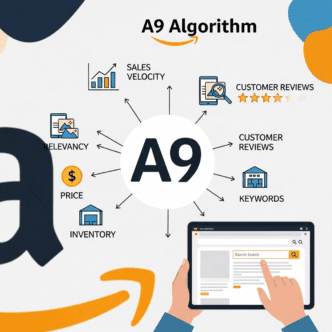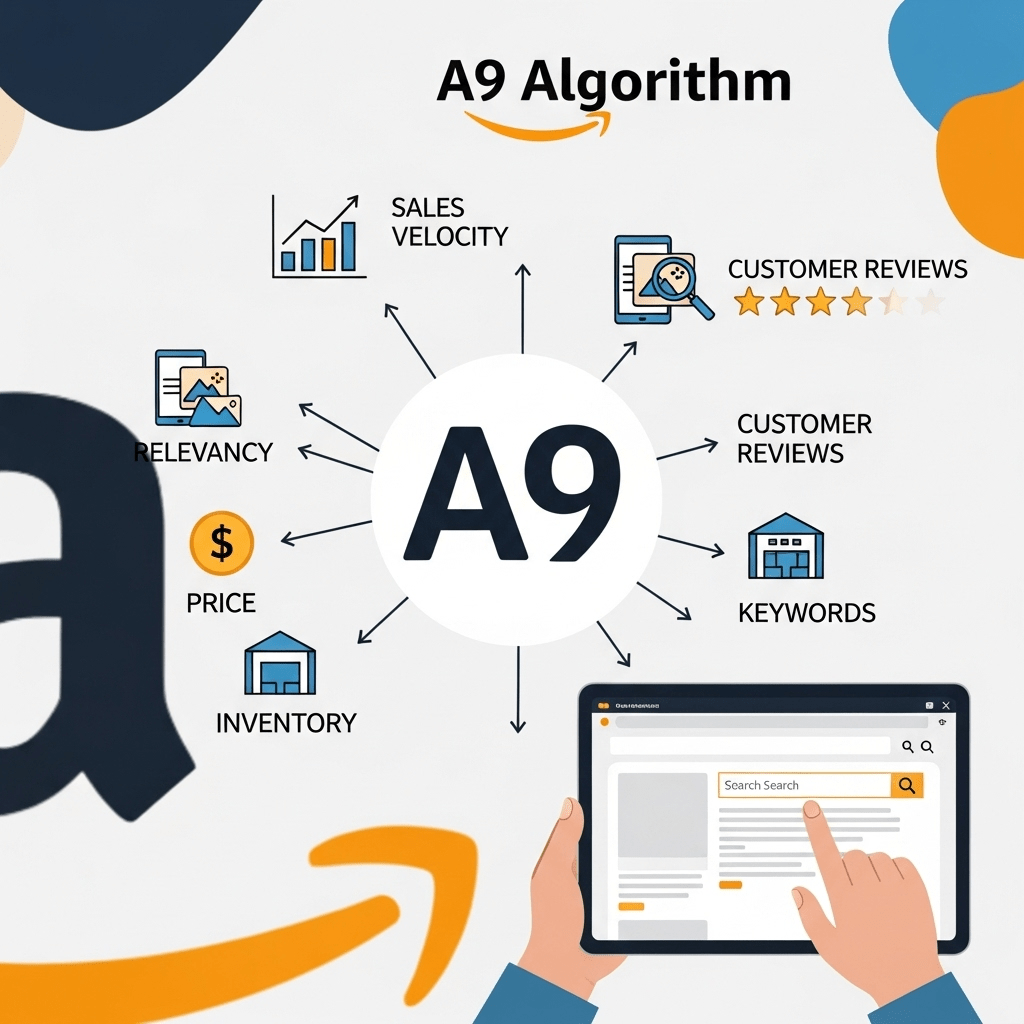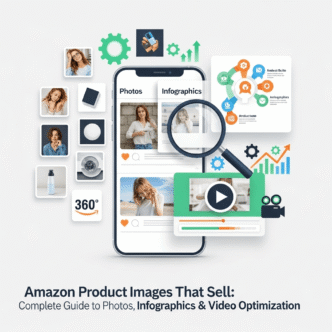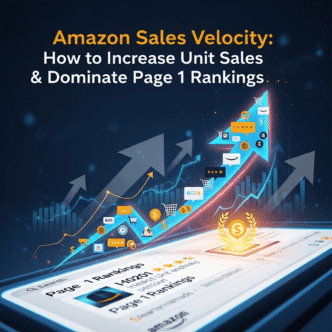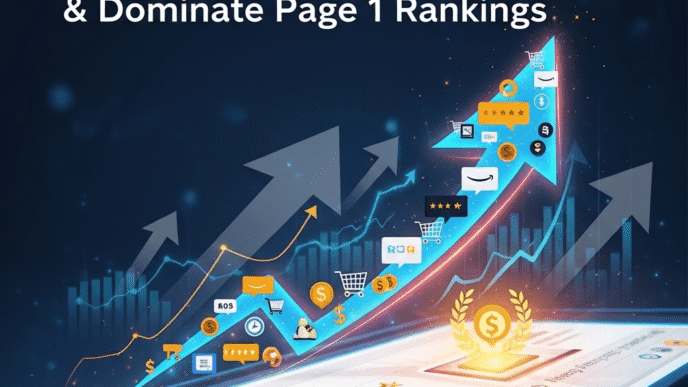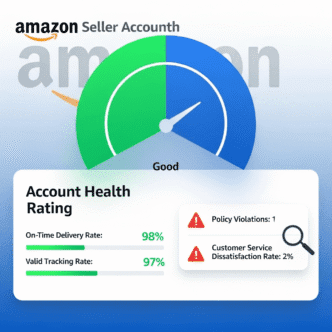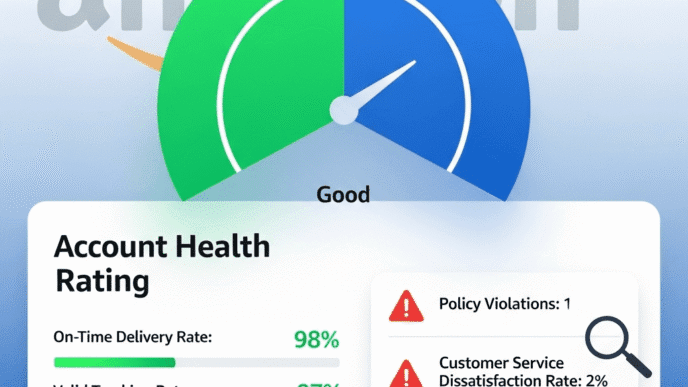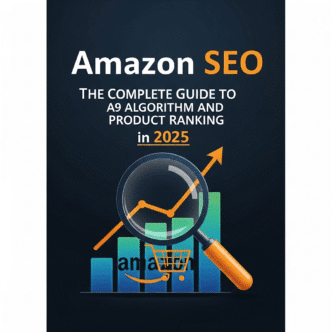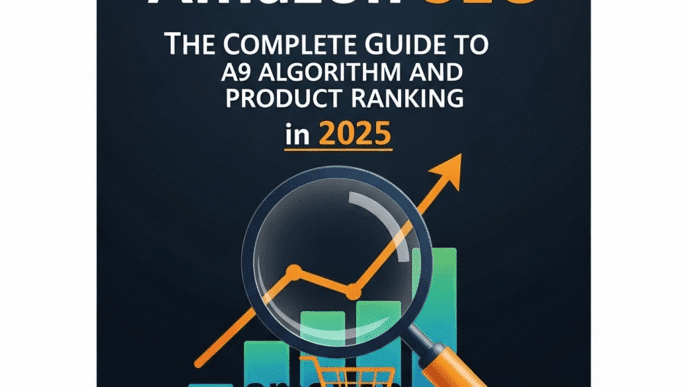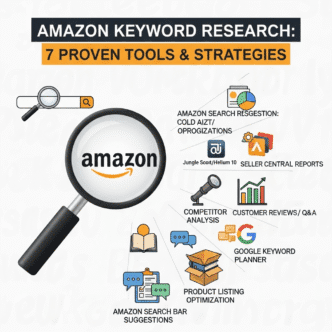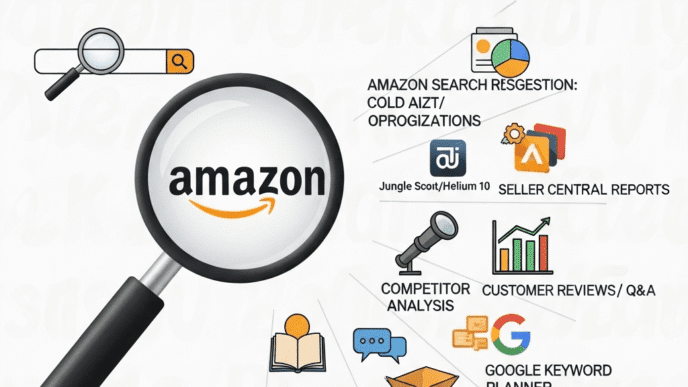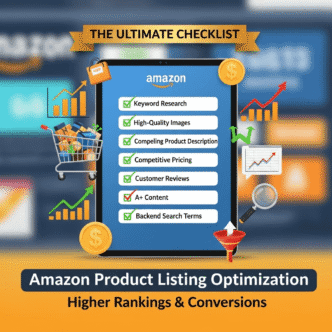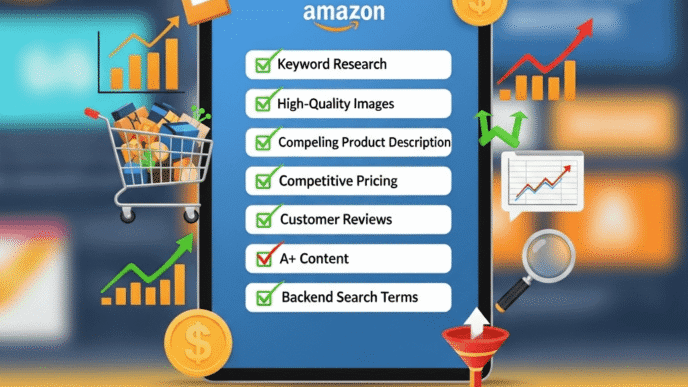Your product is amazing. Your listing is optimized. Your PPC is running. But you’re stuck on page 3, watching competitors with inferior products dominate page 1.
What gives?
The Amazon A9 algorithm – that’s what. It’s the invisible force that decides which products get seen and which disappear into the abyss of page 47. And in 2025, it’s smarter, more complex, and more ruthless than ever.
Here’s the truth: Understanding how the Amazon A9 algorithm works is the difference between building a six-figure Amazon business and wondering why you can’t even break even. The algorithm isn’t your enemy—it’s actually trying to help you succeed. You just need to speak its language.
In this guide, I’m breaking down exactly what the Amazon A9 algorithm is, how it ranks products, what changed in 2025, and most importantly—how to optimize your listings to work with the algorithm instead of against it.
No conspiracy theories. No outdated advice. Just the data-driven strategies that actually move the needle.
Let’s decode Amazon’s billion-dollar ranking system.
Table of Contents
Toggle
What Is the Amazon A9 Algorithm?
The Amazon A9 algorithm is Amazon’s proprietary search engine that determines which products appear when customers search for something. Think of it as Amazon’s version of Google’s algorithm, but with one crucial difference.
Google wants to show you the most relevant information.
Amazon wants to show you products you’ll actually buy.
This fundamental difference changes everything about how the algorithm works.
The A9 vs. A10 Confusion Explained
You might hear sellers talk about “A9” and “A10” interchangeably. Here’s the reality:
A9 is the original name of Amazon’s search algorithm (named after A9.com, Amazon’s search subsidiary)
A10 was a rumored major update around 2019-2020 that increased the weight of external traffic and customer satisfaction signals
A13 is allegedly the current iteration (though Amazon doesn’t officially announce version numbers)
What matters: The core principles remain the same regardless of what version number you call it. Amazon updates its algorithm continuously, not in massive once-per-year overhauls like Google.
Pro Tip: Stop obsessing over whether it’s A9, A10, or A13. Amazon updates its algorithm thousands of times per year. Focus on the fundamental ranking factors that have remained consistent: relevance, performance, and customer satisfaction.
How Does the Amazon A9 Algorithm Actually Work?
Let’s cut through the complexity. The Amazon search algorithm has one primary goal: maximize revenue per customer search.
This means showing products that:
- Match what the customer is searching for (relevance)
- Are likely to get purchased (conversion probability)
- Keep customers happy (satisfaction and retention)
The Three Pillars of Amazon’s Ranking System
Pillar 1: Relevance (Are You The Right Product?)
Amazon determines if your product matches the search query using:
- Keywords in your title, bullets, description, and backend terms
- Product category and attributes
- Historical search patterns (what keywords led to your product being purchased)
- Semantic understanding (AI that understands synonyms and intent)
Pillar 2: Performance (Do Customers Buy Your Product?)
Amazon tracks whether customers actually purchase your product:
- Click-through rate (CTR) from search results
- Conversion rate (sessions to purchases)
- Sales velocity (units sold per time period)
- Add-to-cart rate
- Time spent on your listing
Pillar 3: Customer Satisfaction (Do They Like What They Got?)
Amazon measures post-purchase satisfaction:
- Product reviews and ratings
- Return rate
- Customer questions answered
- A-to-Z claims and negative feedback
- Repeat purchases
These three pillars work together. You can’t dominate with just one—you need all three.
For a complete breakdown of how these factors integrate with your overall strategy, see our comprehensive Amazon SEO guide.
What Are the Amazon A9 Algorithm Ranking Factors for 2025?
Let’s get specific. Here are the Amazon A9 algorithm ranking factors that matter most, ranked by impact.
Factor #1: Sales Velocity (The King)
What it is: How many units you sell in a given time period (usually measured daily)
Why it matters: Sales velocity is the single strongest ranking signal. High velocity tells Amazon “customers want this product.”
How it’s calculated: Not just raw sales, but sales relative to your category and search volume for your keywords
Example: Selling 50 yoga mats/day ranks you higher than selling 50 dog beds/day if yoga mat searches are 10x higher
Optimization tactics:
- Run aggressive PPC campaigns to drive initial velocity
- Launch with competitive pricing to maximize sales
- Use Amazon Vine and review strategies to build social proof fast
- Time launches during high-demand seasons
Pro Tip: Amazon tracks sales velocity at the keyword level. If customers search “wireless earbuds” and buy your product, your velocity for that specific keyword increases. This is why PPC campaigns that target the right keywords are so powerful for organic ranking.
Factor #2: Conversion Rate (The Queen)
What it is: Percentage of visitors who purchase your product (Orders ÷ Sessions × 100)
Why it matters: High conversion tells Amazon “when people see this product, they buy it.” This makes Amazon want to show it more.
Benchmark targets:
- Below 8%: Poor (something’s wrong with your listing)
- 8-12%: Average (you’ll survive but not thrive)
- 12-18%: Good (competitive in most categories)
- 18%+: Excellent (you’re a conversion machine)
What affects conversion:
- Main image quality (single biggest factor)
- Price competitiveness (people comparison shop)
- Review count and rating (social proof)
- Bullet points and listing copy (do they answer questions?)
- A+ Content (visual storytelling)
- Prime eligibility (huge trust signal)
Optimization tactics:
- A/B test your main image obsessively
- Price within 10% of top competitors
- Get to 25+ reviews ASAP (credibility threshold)
- Write benefit-focused bullets, not feature lists
For detailed conversion optimization strategies, check our guide on Amazon listing optimization.
Factor #3: Relevance Score (The Gatekeeper)
What it is: How well your product matches the search query
Why it matters: If Amazon doesn’t think you’re relevant, you won’t even show up in search results to get clicks
How Amazon determines relevance:
- Exact keyword matches in title (highest weight)
- Keywords in bullet points (medium weight)
- Keywords in description (lower weight)
- Backend search terms (invisible but important)
- Product category and attributes (surprisingly important)
- Historical conversion data (customers searching X bought your product)
Optimization tactics:
- Front-load primary keywords in your title (first 5 words crucial)
- Include secondary keywords naturally in bullets
- Fill all 249 bytes of backend search terms
- Select the most specific product category possible
- Complete every attribute field (size, color, material, etc.)
Factor #4: Click-Through Rate (CTR) (The Attention Getter)
What it is: How often people click your product when it appears in search results
Why it matters: Low CTR signals “people see this product but don’t want to learn more.” Amazon penalizes low CTR.
What affects CTR:
- Main image (80% of CTR comes from this)
- Title appeal (does it communicate value?)
- Price display (competitive or not?)
- Prime badge (huge trust and convenience factor)
- Review count and stars (social proof at a glance)
- Best Seller or Amazon’s Choice badges
Optimization tactics:
- Professional, high-contrast main image on pure white background
- Show product in context or scale (customers need to visualize size)
- Title that communicates clear benefit, not just features
- Competitive pricing within your category
- Get Prime eligibility (FBA if possible)
Pro Tip: Amazon tracks CTR at the keyword level. If you rank for “yoga mat” but have terrible CTR, Amazon will demote you for that keyword specifically, even if your overall performance is good. This is why keyword-specific optimization matters.
Factor #5: Customer Reviews and Ratings (The Trust Builder)
What it is: Number of reviews, average star rating, and review velocity
Why it matters: Reviews directly impact conversion (social proof) and Amazon trusts products that customers vouch for
The review rating impact:
- 4.8-5.0 stars: Premium product, minimal resistance
- 4.5-4.7 stars: Competitive, customers comfortable buying
- 4.0-4.4 stars: Acceptable but conversion suffers 20-30%
- Below 4.0 stars: Major handicap, needs immediate fixing
The review count impact:
- 0-10 reviews: New product penalty, hard to rank
- 10-25 reviews: Minimum credibility threshold
- 25-100 reviews: Competitive in most categories
- 100-500 reviews: Strong social proof advantage
- 500+ reviews: Dominance signal, hard to overcome
Optimization tactics:
- Enroll in Amazon Vine immediately at launch ($200 for 20-30 reviews)
- Use Request a Review button for every order (5-7 days after delivery)
- Respond to negative reviews professionally within 48 hours
- Monitor review velocity (getting reviews consistently matters)
For complete strategies on building your review profile, see our guide on getting Amazon reviews fast.
Factor #6: Price Competitiveness (The Value Signal)
What it is: Where your price sits relative to similar products
Why it matters: Amazon wants to offer customers value. Overpriced products get buried.
How Amazon evaluates price:
- Comparison to similar products in same category
- Historical pricing (are you always discounting? Suspicious)
- Price relative to perceived quality (reviews, brand, presentation)
- External price comparisons (Amazon checks other marketplaces)
Optimization tactics:
- Price within 15% of your top 5 competitors
- Launch pricing 10-20% below market to gain momentum
- Use temporary discounts strategically, not permanently
- Justify premium pricing with superior reviews and presentation
Pro Tip: Being the cheapest isn’t always optimal. A $25 product with 200 five-star reviews often outsells a $20 product with 50 mixed reviews. Amazon’s algorithm considers total value, not just price.
Factor #7: Fulfillment Method (The Trust Multiplier)
What it is: FBA (Fulfilled by Amazon) vs. FBM (Fulfilled by Merchant)
Why it matters: FBA products get ranking preference because Amazon trusts its own fulfillment
FBA advantages:
- Prime eligibility (150+ million Prime members prefer Prime products)
- Faster, more reliable shipping (Better customer experience)
- Better return experience (Amazon handles it)
- Higher customer trust (Amazon’s reputation backing you)
- Higher conversion rates (typically 20-30% higher than FBM)
When FBM makes sense:
- Oversized/heavy products (high FBA fees)
- Low-margin products (FBA fees eat profit)
- Custom/made-to-order products (can’t pre-ship inventory)
Optimization tactics:
- Use FBA for most standard products
- Enroll in programs like Small & Light for small, low-price items
- Maintain healthy inventory levels (stockouts kill ranking)
- Consider FBA for new launches, switch to FBM once established (if needed)
Factor #8: Session Duration and Engagement (The Interest Signal)
What it is: How long customers spend on your product page and what they do
Why it matters: Long sessions signal “this product is interesting and worth considering”
What Amazon tracks:
- Time on page (longer is better)
- Scroll depth (did they read bullets and description?)
- Image interactions (did they view multiple images?)
- Video plays (high engagement signal)
- Comparison actions (viewed Similar Products, etc.)
Optimization tactics:
- Engaging A+ Content that tells a story
- Multiple high-quality images showing different angles and uses
- Product videos (30-60 seconds showing product in action)
- Detailed, scannable bullet points that keep people reading
- Clear, comprehensive FAQ section
Factor #9: Inventory Availability (The Consistency Factor)
What it is: Whether you’re in stock and how consistently you maintain inventory
Why it matters: Stockouts kill your ranking momentum. Amazon won’t promote products that frequently go out of stock.
The stockout penalty:
- Immediate ranking drop when out of stock (product disappears from search)
- Slow recovery even after restocking (takes 2-4 weeks to regain previous position)
- Cumulative damage (frequent stockouts = lower trust from algorithm)
Optimization tactics:
- Maintain 60-90 days of inventory at all times
- Set up reorder alerts at 30-day threshold
- Use Amazon’s Inventory Performance Index (IPI) tools
- Consider safety stock for your best sellers
- Plan for seasonality (don’t run out during Q4)
Pro Tip: If you’re approaching a stockout, lower your PPC bids dramatically 2 weeks before running out. This slows sales velocity and extends your inventory. Better to rank lower temporarily than stock out completely.
Factor #10: External Traffic Quality (The 2025 Game Changer)
What it is: Traffic you bring to Amazon from outside sources (social media, Google, influencers)
Why it matters: Since ~2019-2020 algorithm updates, Amazon rewards sellers who bring new customers to the platform
What counts as quality external traffic:
- Traffic that actually converts (not just clicks)
- Traffic from reputable sources (branded channels, not sketchy link farms)
- Traffic tracked through Amazon Attribution (so Amazon knows it’s yours)
Sources that work:
- Instagram/TikTok product content
- YouTube reviews and demos
- Google Ads (yes, you can advertise on Google for Amazon products)
- Email marketing to your customer list
- Influencer partnerships
Optimization tactics:
- Use Amazon Attribution links to track external traffic
- Focus on channels where your target customers already engage
- Create valuable content first, drive traffic second (not the reverse)
- Track conversion rates from each channel (some drive junk traffic)
Amazon Ranking Factor Impact Comparison Table
| Ranking Factor | Impact on Ranking | Optimization Difficulty | Timeline to Impact |
|---|---|---|---|
| Sales Velocity | ⭐⭐⭐⭐⭐ | 🔥 Hard | 7-14 days |
| Conversion Rate | ⭐⭐⭐⭐⭐ | 🔥 Hard | 3-7 days |
| Relevance Score | ⭐⭐⭐⭐⭐ | ✅ Easy | 1-3 days |
| Click-Through Rate | ⭐⭐⭐⭐ | ⚡ Medium | 3-7 days |
| Reviews & Ratings | ⭐⭐⭐⭐ | 🔥 Hard | 30-90 days |
| Price Competitiveness | ⭐⭐⭐⭐ | ✅ Easy | 1 day |
| Fulfillment Method | ⭐⭐⭐⭐ | ⚡ Medium | Immediate |
| Session Duration | ⭐⭐⭐ | ⚡ Medium | 7-14 days |
| Inventory Availability | ⭐⭐⭐ | ⚡ Medium | Immediate (negative) |
| External Traffic | ⭐⭐⭐ | 🔥 Hard | 14-30 days |
What Changed in the Amazon Algorithm in 2025?
The Amazon algorithm changes 2025 aren’t radical overhauls—they’re evolutionary refinements. Here’s what’s different.
Change #1: AI-Powered Semantic Search
What changed: Amazon’s natural language processing (NLP) got significantly smarter
What this means:
- Amazon understands search intent, not just exact keywords
- Synonyms and related terms now work better
- Conversational long-tail searches are increasing
Example: Searching “headphones good for small ears” now shows relevant products even if they don’t have that exact phrase. Amazon understands intent.
How to adapt:
- Write naturally in your bullets and description
- Use variations of your main keywords (synonyms)
- Focus on solving customer problems, not just keyword stuffing
- Answer questions customers actually ask
Change #2: Increased Weight on Post-Purchase Behavior
What changed: Amazon now tracks what happens after the sale more heavily
Signals Amazon tracks:
- Return rate (high returns = ranking penalty)
- Time-to-return (fast returns = bigger penalty)
- Repeat purchases (customers buying again = huge positive)
- Review left after purchase (engaged customers = quality product)
How to adapt:
- Ensure product accuracy (listing should match reality exactly)
- Include detailed sizing/spec information (reduce surprise returns)
- Quality control (fewer defects = fewer returns)
- Follow-up customer service (solve issues before they return product)
Change #3: Mobile-First Ranking Signals
What changed: Mobile experience now heavily influences ranking
What this means:
- Mobile conversion rate weighted more than desktop
- Image readability on mobile matters more
- Page load speed on mobile affects ranking
- Mobile title display (first 80 characters) more critical
How to adapt:
- Test your listing on mobile devices (most customers shop on phones)
- Ensure main image is clear at thumbnail size
- Keep title under 150 characters (anything longer gets cut off)
- Use larger text in infographic images (mobile users can’t read tiny text)
Change #4: Video Content Prioritization
What changed: Products with videos get ranking boosts
Why: Video increases session duration and conversion rates dramatically
The impact:
- 30-40% higher conversion with product video
- Longer average session time (good engagement signal)
- Lower return rates (customers know what they’re getting)
How to adapt:
- Create 30-60 second product demo video
- Show product in actual use, not just rotating on white background
- Include in main image gallery AND A+ Content
- Focus on demonstrating key features visually
Change #5: Sustainability and Climate Pledge Friendly
What changed: Amazon is promoting eco-friendly products more visibly
The program: Products with sustainability certifications get “Climate Pledge Friendly” badge
Ranking impact: Minor direct boost, but significant indirect boost through higher CTR (customers like eco-friendly)
How to adapt:
- Get relevant certifications if applicable (Compact by Design, etc.)
- Use recyclable packaging
- Highlight eco-friendly features in bullets
- Apply for Climate Pledge Friendly badge
Pro Tip: These algorithm changes aren’t secret. Amazon publishes many updates in Seller Central news. Check the “News” section weekly. You’ll often find hints about what Amazon is prioritizing.
Understanding Amazon Search Algorithm: How Ranking Actually Happens
Let’s walk through exactly what happens when a customer searches on Amazon. Understanding this process helps you optimize at each stage.
Stage 1: Query Understanding (Millisecond 1-50)
What happens: Amazon’s AI interprets the search query
Process:
- Identifies main keywords and intent
- Recognizes synonyms and related terms
- Checks customer’s search history (personalization)
- Determines product category most likely to match
- Filters for customer’s location (shipping considerations)
Your optimization: Ensure your product is in the right category with accurate attributes
Stage 2: Candidate Selection (Millisecond 50-200)
What happens: Amazon narrows millions of products to a few hundred candidates
Criteria:
- Keyword relevance (do keywords match?)
- Category match (right type of product?)
- Availability (in stock?)
- Shipping eligibility (can ship to customer’s location?)
- Historical performance (has this product converted for similar searches before?)
Your optimization: Strong keyword optimization in title and backend terms gets you into this pool
Stage 3: Ranking Calculation (Millisecond 200-400)
What happens: Amazon ranks the candidates using its algorithm
Factors considered:
- Sales velocity for this keyword
- Conversion rate
- Customer satisfaction signals
- Price competitiveness
- Fulfillment method
- Customer’s personal preferences (previous purchases, browsing history)
Your optimization: All the ranking factors discussed earlier determine your position here
Stage 4: Personalization Layer (Millisecond 400-500)
What happens: Amazon personalizes results for each customer
Adjustments:
- Previously viewed products move up
- Products similar to past purchases move up
- Price range preferences
- Brand preferences
- Prime vs. non-Prime filtering
Your optimization: You can’t control personalization, but broad appeal helps (more customers = more personalized matches)
Stage 5: Display (Millisecond 500)
What happens: Results appear on customer’s screen
Format:
- Sponsored ads (top 3-4 positions)
- Organic results (starting position 5+)
- Filters and refinements on left sidebar
- “Customers also bought” and other recommendations
Your optimization: High CTR from your position ensures you stay there or move up
Pro Tip: Amazon re-ranks results in real-time based on customer behavior. If many customers click your product but don’t buy, your ranking drops for that session’s subsequent searches. The algorithm is constantly learning and adapting.
How to Optimize for the Amazon A9 Algorithm: The Complete Strategy
Now that you understand how the Amazon ranking algorithm works, here’s your optimization playbook.
Phase 1: Foundation (Week 1-2)
Goal: Get the basics right so you’re eligible to rank
Actions:
✅ Keyword Research:
- Use Helium 10 or Jungle Scout to find high-volume, relevant keywords
- Identify 1 primary keyword, 5 secondary keywords, 20 long-tail keywords
- Check Search Term Report from PPC for proven converters
✅ Listing Optimization:
- Title: Include primary keyword in first 5 words, keep under 200 characters
- Bullets: Feature-benefit format, include secondary keywords naturally
- Backend: Fill all 249 bytes with relevant search terms
- Images: Minimum 7 high-quality images, professional main image
✅ Category and Attributes:
- Select most specific category possible
- Complete every attribute field (size, color, material, features)
- Add all relevant product identifiers (UPC, EAN, model number)
✅ Inventory and Fulfillment:
- Send 60+ days of inventory to FBA
- Enroll in Small & Light if eligible
- Set up automatic reorder alerts
For detailed listing optimization tactics, see our Amazon listing optimization guide.
Phase 2: Launch Velocity (Week 3-6)
Goal: Generate initial sales velocity to signal quality to algorithm
Actions:
✅ Amazon Vine:
- Enroll immediately ($200 for 20-30 reviews)
- Expect reviews within 30-45 days
- Get to 25+ reviews as fast as possible
✅ Launch Pricing:
- Price 15-20% below competitors for first 30 days
- Use coupons or Lightning Deals for extra visibility
- Focus on volume over margin temporarily
✅ Aggressive PPC:
- Daily budget: $50-100 (adjust for your margins)
- Auto campaign + Manual exact for top keywords
- Bid aggressively for top of search placement
- Accept higher ACoS during launch (40-60% is okay)
✅ Review Requests:
- Use Request a Review button for every order (5-7 days after delivery)
- Consider automation tools (FeedbackWhiz, Helium 10)
- Monitor reviews daily, respond to negatives within 24 hours
Phase 3: Optimization (Week 7-12)
Goal: Improve efficiency while maintaining momentum
Actions:
✅ Conversion Rate Optimization:
- A/B test main image (Amazon’s Manage Your Experiments)
- Test different price points
- Add product video if not already present
- Enhance A+ Content with comparison charts
✅ PPC Refinement:
- Add 50+ negative keywords from Search Term Report
- Lower bids on non-converters by 20-30%
- Increase bids on top performers by 15-25%
- Launch product targeting campaigns for competitor ASINs
✅ Review Building:
- Continue review requests for every order
- Implement product inserts (thank you card with QR to support resources)
- Solve customer issues proactively (prevents negative reviews)
- Aim for 4.5+ average rating, 50+ total reviews by end of phase
✅ External Traffic Testing:
- Launch small Instagram or TikTok campaigns
- Test influencer partnerships (micro-influencers are cost-effective)
- Use Amazon Attribution to track what drives conversions
- Scale channels that deliver 8%+ conversion rate
Phase 4: Scaling (Week 13+)
Goal: Maximize visibility and profitability
Actions:
✅ Price Optimization:
- Gradually increase price to market rate (or 5-10% above if reviews support it)
- Test premium positioning (sometimes higher price = higher perceived quality)
- Use dynamic pricing tools if managing multiple SKUs
✅ PPC Efficiency:
- Reduce PPC budget by 20-30% as organic takes over
- Target ACoS of 20-30% (down from 40-60% at launch)
- Launch Sponsored Brands campaigns (if 3+ products)
- Test Sponsored Display for retargeting
✅ Content Expansion:
- Create variation listings (colors, sizes, bundles) to pool reviews
- Publish 2-3 Amazon Posts per week
- Update A+ Content seasonally
- Add FAQ section addressing common customer questions
✅ Reputation Management:
- Maintain 4.5+ star average (critical for sustained ranking)
- Respond to all reviews (engagement signals quality)
- Monitor return rate (keep below 5%)
- Track IPI score (keep above 500)
Pro Tip: Optimization is never “done.” Set a standing weekly meeting (even if just with yourself) to review metrics, adjust bids, add negative keywords, and test new tactics. The sellers who win are those who continuously optimize.
Real-World Algorithm Case Study: Page 5 to Page 1 in 60 Days
Let me show you how understanding the algorithm translates to real results.
The Product: Resistance Bands Set
Starting Position (Day 0):
- Ranking: Page 5, position 89 for main keyword “resistance bands”
- Reviews: 12 reviews, 4.1-star average
- Daily sales: 3-5 units
- Conversion rate: 6%
- PPC ACoS: 65%
Problems Identified:
- Low review count (below credibility threshold)
- Poor conversion rate (listing issues)
- Weak relevance signals (keyword optimization poor)
- No external traffic (missing algorithm boost)
The Strategy
Week 1-2: Foundation Fix
Actions:
- Rewrote title with primary keyword in position 2 (was position 8)
- Optimized bullets using Feature-Benefit formula
- Replaced main image (old image was cluttered, new image showed clear product + scale)
- Filled backend keywords completely (was only using 140 of 249 bytes)
- Enrolled in Amazon Vine ($200)
Results:
- Ranking improved to page 4, position 68
- Conversion rate: 6% → 8.5%
- Daily sales: 5-7 units
Week 3-4: Velocity Push
Actions:
- Reduced price from $24.99 to $19.99 (20% discount)
- Launched aggressive PPC ($75/day budget, +60% top of search)
- Vine reviews started arriving (18 reviews received)
- Created product video (30 seconds showing bands in use)
Results:
- Ranking jumped to page 3, position 42
- Total reviews: 30 (12 original + 18 Vine)
- Average rating improved: 4.1 → 4.5 stars
- Conversion rate: 8.5% → 11.2%
- Daily sales: 18-22 units
- PPC ACoS: Still high at 58%
Week 5-6: Optimization Phase
Actions:
- Added 73 negative keywords from Search Term Report
- Lowered PPC bids by 15% on medium performers
- Increased bids by 25% on top 5 keywords
- Launched Instagram campaign with micro-influencer ($200)
- Used Amazon Attribution to track external traffic
Results:
- Ranking: Page 2, position 24
- Conversion rate: 11.2% → 13.8%
- Daily sales: 28-32 units
- PPC ACoS improved: 58% → 42%
- External traffic: 87 clicks, 9 conversions (10.3% CVR)
Week 7-8: Scaling and Price Recovery
Actions:
- Increased price to $22.99 (still below original $24.99)
- Reduced PPC budget to $50/day (organic picking up slack)
- Continued review requests for all orders
- Launched product targeting campaigns for top 3 competitor ASINs
Results:
- Ranking: Page 1, position 12
- Total reviews: 47 (organic reviews accelerating)
- Average rating: 4.6 stars
- Conversion rate: 13.8% → 15.1%
- Daily sales: 35-40 units
- PPC ACoS: 42% → 32%
- TACoS (Total ACoS): 18% (PPC + organic combined)
The 60-Day Transformation
Before:
- Page 5, position 89
- 12 reviews, 4.1 stars
- 6% conversion rate
- 3-5 units/day
- $360-600/month revenue
After:
- Page 1, position 12
- 47 reviews, 4.6 stars
- 15.1% conversion rate
- 35-40 units/day
- $24,000-27,500/month revenue
Total Investment:
- Vine: $200 + ~$300 products = $500
- PPC: ~$3,500 over 60 days
- Price discounting: ~$750 (lost margin)
- External traffic test: $200
- Image/video production: $150
- Total: ~$5,100
ROI:
- Revenue increase: ~$25,000/month
- Profit increase (at 40% margin): ~$10,000/month
- ROI: 196% in first month after optimization
- Payback period: 15 days
Key Takeaways
The algorithm rewards velocity. Once sales momentum started (week 3-4), ranking improved exponentially.
Reviews are a multiplier. Going from 12 to 47 reviews increased conversion rate by 150%+.
Keyword optimization is foundational. Title fix alone improved ranking by 21 positions.
PPC builds organic. High PPC spend drove sales that improved organic ranking, allowing PPC reduction later.
Price is a lever, not a permanent strategy. Launch discount got momentum; price recovery maintained it.
This is exactly how the Amazon search algorithm responds to systematic optimization.
Common Amazon Algorithm Myths Debunked
Let’s kill some misconceptions that cost sellers money.
Myth #1: “Amazon Penalizes Sellers to Favor Its Own Products”
Reality: Amazon doesn’t need to penalize sellers. Private label products (Amazon Basics, etc.) often perform well because they have competitive pricing, good reviews, and strong velocity—not because of algorithm manipulation.
Truth: Focus on beating Amazon’s products the same way you’d beat any competitor: better price, better reviews, better conversion rate.
Myth #2: “The Algorithm Changes Constantly, So There’s No Point Optimizing”
Reality: Core ranking factors (velocity, conversion, relevance) haven’t changed in years. Minor updates happen continuously, but fundamentals remain stable.
Truth: Optimize for fundamentals. You’ll be 90% correct even through algorithm updates.
Myth #3: “Keyword Stuffing Still Works”
Reality: Amazon’s NLP is sophisticated. Keyword stuffing hurts readability, lowers conversion, and gets penalized.
Truth: Write naturally. Include keywords where they fit organically. The algorithm understands synonyms and intent.
Myth #4: “External Traffic Doesn’t Matter for Amazon”
Reality: Since ~2019, external traffic has been a meaningful ranking signal (when it converts).
Truth: Quality external traffic can boost rankings 10-20%. Track with Amazon Attribution and focus on channels that actually convert.
Myth #5: “Once You Rank, You’re Set”
Reality: Rankings require constant maintenance. Competition improves. Algorithm updates shift things. Lose momentum, lose rankings.
Truth: Allocate 20% of your time to ongoing optimization even after reaching page 1. It’s easier to maintain than rebuild.
Myth #6: “Reviews Are the Most Important Factor”
Reality: Reviews matter, but sales velocity matters more. A product with 50 reviews selling 100 units/day ranks higher than a product with 500 reviews selling 20 units/day.
Truth: Reviews enable velocity (through conversion), but velocity itself is the king ranking factor.
Myth #7: “Amazon Rewards Longevity (Older Listings Rank Better)”
Reality: Amazon doesn’t care how old your listing is. A 5-year-old listing with declining sales gets buried. A 30-day-old listing with explosive growth dominates.
Truth: Current performance matters infinitely more than historical performance.
Pro Tip: When you hear algorithm conspiracy theories, ask: “Does this align with Amazon’s goal of maximizing revenue per customer?” If not, it’s probably false. Amazon’s incentives are clear—show products customers will buy.
How AI and Machine Learning Changed the Amazon Algorithm
The Amazon search engine now uses sophisticated AI that fundamentally changes how sellers should approach optimization.
AI-Powered Customer Intent Recognition
What it does: Amazon’s neural networks understand what customers really want, not just what they typed.
Example:
- Search: “headphones gym”
- Old algorithm: Shows any headphones mentioning “gym”
- New AI algorithm: Understands customer wants sweatproof, secure-fit, wireless headphones for working out
How to optimize:
- Think about customer problems not just product features
- Use natural language that answers questions
- Include use-case keywords (“for running,” “for small ears,” “for travel”)
Predictive Ranking Based on Behavior Patterns
What it does: AI predicts which products a specific customer will buy based on their unique behavior patterns.
Signals AI uses:
- Previous purchases in this category
- Time spent on similar products
- Add-to-cart but didn’t buy (reconsidering)
- Searches over past 30 days
- Browsing patterns (impulse buyer vs. researcher)
How to optimize:
- Broad appeal increases chances of matching different customer patterns
- Variations (colors, sizes) capture more pattern matches
- Strong conversion rate across ALL customer types (not just your “ideal” buyer)
Real-Time Ranking Adjustments
What it does: Rankings change in real-time based on performance, not just daily/weekly updates.
Example: If your product’s conversion rate drops during a specific 2-hour period, your ranking for searches during that window drops immediately.
How to optimize:
- Monitor performance throughout the day (not just daily averages)
- Use dayparting for PPC (pause during low-conversion hours)
- Fix listing issues immediately (don’t wait for “next optimization cycle”)
Image Recognition and Quality Scoring
What it does: Amazon’s AI analyzes your images for quality, professionalism, and clarity.
What AI evaluates:
- Image resolution and sharpness
- Background cleanliness (pure white or cluttered?)
- Product prominence (does product fill 85% of frame?)
- Lighting quality and color accuracy
- Professional vs. amateur composition
How to optimize:
- Invest in professional product photography ($200-500 one-time cost)
- Use pure white backgrounds (RGB 255, 255, 255)
- Ensure images are 2000x2000px minimum
- Show multiple angles and use-cases across your 9 image slots
Pro Tip: Amazon is testing AI that can automatically extract features from images and add them to product attributes. This means your images need to clearly show key features—the AI is “reading” your photos, not just displaying them.
Amazon Algorithm Updates Timeline (2020-2025)
Understanding Amazon algorithm updates helps you stay ahead. Here’s what changed and when.
2020: The External Traffic Update
What changed: Increased weighting for traffic from outside Amazon
Impact: Products with quality external traffic got 10-15% ranking boost
How sellers adapted: Instagram, TikTok, and influencer marketing became viable strategies
2021: The Review Authenticity Crackdown
What changed: AI detection of fake reviews got dramatically better
Impact: Thousands of sellers suspended for review manipulation
How sellers adapted: Shifted to legitimate methods (Vine, Request a Review)
2022: Mobile-First Indexing
What changed: Mobile conversion rates weighted more heavily than desktop
Impact: Listings not optimized for mobile saw 5-10% ranking drops
How sellers adapted: Mobile-first design, shorter titles, larger text in images
2023: The Sustainability Push
What changed: Climate Pledge Friendly products got visibility boosts
Impact: 8-12% higher CTR for certified products
How sellers adapted: Pursued sustainability certifications, eco-friendly packaging
2024: AI Semantic Search Expansion
What changed: Natural language understanding improved dramatically
Impact: Keyword stuffing became actively penalized rather than just ineffective
How sellers adapted: Natural language in listings, focus on intent over exact matches
2025: Video Content Prioritization
What changed: Products with videos get measurable ranking advantages
Impact: 15-20% higher conversion rates, better engagement metrics
How sellers adapted: Added product demonstration videos to all major listings
Pro Tip: Amazon announces some updates in Seller Central News, but most happen silently. Join Amazon seller communities (Reddit’s r/FulfillmentByAmazon, Facebook groups) to spot algorithm changes early through collective seller observations.
Advanced Algorithm Optimization Tactics
For experienced sellers ready to go deeper, these advanced tactics squeeze out competitive advantages.
Tactic #1: Keyword-Specific Optimization
Don’t optimize your listing generically. Optimize for your top 3 keywords individually.
How:
- Identify your 3 highest-volume target keywords
- For each keyword, check what the top 10 ranking products emphasize
- Adjust your listing to include elements all top-rankers share
- Track ranking for each keyword separately
Example: For “yoga mat,” top products emphasize thickness and grip. For “exercise mat,” they emphasize size and versatility. Optimize differently for each.
Tactic #2: The Ladder Strategy for Variations
Create variations strategically to capture different keyword clusters.
How:
- Variation 1: Optimized for “premium [product]” keywords
- Variation 2: Optimized for “affordable [product]” keywords
- Variation 3: Optimized for “professional [product]” keywords
All variations share reviews, but target different customer segments and keywords.
Tactic #3: Seasonal Keyword Rotation
Update backend keywords quarterly based on seasonal trends.
Example (Yoga Mat):
- Q1 (Jan-Mar): “new year fitness,” “home workout,” “yoga mat beginners”
- Q2 (Apr-Jun): “outdoor yoga,” “travel yoga mat,” “portable mat”
- Q3 (Jul-Sep): “back to school,” “dorm yoga,” “apartment exercise”
- Q4 (Oct-Dec): “yoga mat gift,” “fitness gift,” “wellness present”
Tactic #4: Competitive Moat Building
Once you rank well, make it harder for competitors to catch you.
How:
- Maintain 2x the reviews of your closest competitor
- Price aggressively enough that they can’t profitably undercut you
- Launch variations to own more search real estate
- Build external traffic sources they can’t easily replicate
Tactic #5: The Question-Answer SEO Hack
Seed your Q&A section with keyword-rich questions and answers.
How:
- Ask questions (from a separate account) that include long-tail keywords
- Answer thoroughly as the seller, including related keywords naturally
- This content is indexed and searchable
Example Question: “Does this yoga mat work well for hot yoga and bikram classes?”
Answer: “Yes! Our yoga mat is specifically designed for hot yoga and bikram classes. The non-slip surface maintains grip even with sweat, and the closed-cell design prevents moisture absorption…”
Pro Tip: These advanced tactics require significant time investment. Only pursue them once your fundamentals are solid. A perfectly executed advanced tactic won’t overcome a poorly optimized listing.
Final Thoughts: Mastering the Amazon Algorithm
The Amazon A9 algorithm isn’t a mysterious black box. It’s a predictable system optimizing for one clear goal: maximizing revenue per customer search.
The algorithm rewards:
- Products customers want to buy (high conversion)
- Products customers search for (relevance)
- Products customers love (reviews and low returns)
- Products consistently available (inventory management)
- Products that bring value to Amazon (sales velocity)
The sellers who dominate Amazon understand this simple truth: The algorithm isn’t your enemy. It’s trying to show customers the best products. If you genuinely have a great product and optimize your listing properly, the algorithm will reward you.
Your algorithm optimization strategy should be:
Week 1-2: Fix foundational elements (keywords, images, bullets, category)
Week 3-6: Build momentum (PPC, Vine, pricing, review requests)
Week 7-12: Optimize efficiency (A/B testing, negative keywords, conversion improvements)
Week 13+: Scale and maintain (external traffic, variations, ongoing optimization)
Forever: Monitor, test, adapt (algorithm changes, competition evolves, stay ahead)
The sellers making six and seven figures on Amazon aren’t lucky. They’re systematic. They understand how the algorithm works, optimize every element accordingly, and continuously improve.
You now have the complete blueprint. The algorithm isn’t secret anymore.
Time to rank.
For the complete Amazon strategy including PPC, reviews, and listing optimization, check our comprehensive Amazon SEO guide.
Frequently Asked Questions
Q: What exactly is the Amazon A9 algorithm?
The Amazon A9 algorithm is Amazon’s search engine that determines which products appear when customers search. Unlike Google (which prioritizes information), A9 prioritizes products customers are most likely to purchase. It considers relevance, conversion rate, sales velocity, customer satisfaction, and dozens of other factors to rank products.
Q: How often does Amazon update its algorithm?
Amazon makes thousands of minor updates annually, not one or two major updates like Google. Most changes are small refinements to ranking weights, search understanding, or personalization. Major shifts (like increased external traffic weighting in 2020) happen every 1-2 years. Focus on fundamentals that remain constant rather than chasing every minor update.
Q: What’s the most important ranking factor for the A9 algorithm?
Sales velocity (units sold per time period) is the single strongest ranking factor. High velocity signals to Amazon that customers want your product. However, velocity requires other factors (conversion rate, relevance, reviews) to be strong first. Think of it as: relevance gets you shown → conversion creates velocity → velocity cements your ranking.
Q: How long does it take to rank on page 1 after optimizing?
For low-competition keywords: 2-4 weeks with proper optimization and PPC support. For medium-competition keywords: 6-8 weeks with consistent effort. For high-competition keywords: 3-6 months of sustained optimization, reviews, and sales velocity. There’s no shortcut—it’s a compounding process where each improvement builds on previous ones.
Q: Does Amazon really penalize sellers to favor its own products?
No credible evidence supports this. Amazon’s private label products (Amazon Basics, etc.) perform well because they follow best practices: competitive pricing, fast shipping (obviously), good reviews, and optimization. They don’t need algorithm manipulation—they just execute fundamentals well. Focus on beating them through superior products and optimization, not conspiracy theories.
Q: Do external traffic sources really help Amazon rankings?
Yes, but only if that traffic converts. Since ~2019-2020 algorithm updates, quality external traffic (Instagram, TikTok, YouTube, Google) that actually purchases your product provides a ranking boost. Use Amazon Attribution to track external traffic. Traffic with 8%+ conversion rate helps; traffic with 2% conversion hurts. Quality matters more than quantity.
Q: How do I know if an algorithm update hurt my ranking?
Check these indicators: Sudden ranking drop (5+ positions) within 2-3 days across multiple keywords. Traffic drop not explained by seasonality or PPC changes. Conversion rate drop suggesting listing is showing to wrong audience. If you see these, check Seller Central news and seller forums to see if others report similar issues. Often it’s not algorithm—it’s increased competition or your own listing issues.
Q: Should I optimize for A9, A10, or A13?
This is a distraction. Amazon doesn’t officially announce version numbers. The core principles remain consistent regardless of what version insiders call it: relevance, performance, and customer satisfaction. Optimize for these fundamentals and you’ll succeed regardless of version updates. Version number discussions are mostly seller folklore.
Q: Can I “game” the Amazon algorithm?
Not sustainably. Temporary hacks (like super URLs, two-step URLs, fake reviews) either don’t work anymore or risk permanent suspension. Amazon’s AI detects manipulation patterns. The only “hack” that works long-term is genuinely having a great product, optimizing properly, and driving consistent sales. Shortcuts fail; fundamentals compound.
Q: How does the algorithm treat new products vs. established products?
New products don’t get a “new product boost”—that’s a myth. They start with zero ranking because they have no sales history. However, new products can rank quickly if they generate velocity fast (through PPC, pricing, reviews). Established products have momentum advantage, but they can lose it through stockouts, declining reviews, or complacency. Current performance always trumps history.
Q: Does changing my listing hurt my ranking temporarily?
Minor changes (price, bullets) usually don’t cause ranking drops. Major changes (title, category, main image) can cause temporary fluctuation (2-7 days) as Amazon’s algorithm reassesses your product. Make significant changes during low-traffic periods (Monday-Wednesday) to minimize impact. Test major changes with A/B testing tools before fully implementing.
Q: How important are backend search terms really?
Very important for relevance but often misunderstood. Backend terms don’t directly rank you—they make you eligible to appear in searches. Think of them as “qualification” rather than “promotion.” Fill all 249 bytes with relevant keywords not in your visible content. Don’t repeat keywords already in title/bullets. Include synonyms, misspellings, and alternative terms customers might search.
📊 Amazon A9 Algorithm Key Statistics
⭐ Top 10 Ranking Factors Impact Score
1. Sales Velocity
2. Conversion Rate
3. Relevance Score
4. Click-Through Rate
5. Reviews & Ratings
6. Price Competitiveness
📋 Ranking Factor Comparison Table
| Ranking Factor | Impact | Optimization Difficulty | Time to Results |
|---|---|---|---|
| Sales Velocity | ⭐⭐⭐⭐⭐ | Hard | 7-14 days |
| Conversion Rate | ⭐⭐⭐⭐⭐ | Hard | 3-7 days |
| Relevance Score | ⭐⭐⭐⭐⭐ | Easy | 1-3 days |
| Click-Through Rate | ⭐⭐⭐⭐ | Medium | 3-7 days |
| Reviews & Ratings | ⭐⭐⭐⭐ | Hard | 30-90 days |
| Price Competitiveness | ⭐⭐⭐⭐ | Easy | 1 day |
| Fulfillment Method | ⭐⭐⭐⭐ | Medium | Immediate |
| External Traffic | ⭐⭐⭐ | Hard | 14-30 days |
🔄 How A9 Algorithm Processes a Search
🧮 Amazon Ranking Score Calculator
Enter your metrics to calculate your estimated ranking potential:
Your Ranking Potential Score:
📅 Amazon Algorithm Updates Timeline (2020-2025)
2025 - Video Content Prioritization
Impact: Products with videos get 15-20% higher conversion rates and ranking boosts.
2024 - AI Semantic Search Expansion
Impact: Natural language understanding improved. Keyword stuffing actively penalized.
2023 - Sustainability Push
Impact: Climate Pledge Friendly products get 8-12% higher CTR visibility.
2022 - Mobile-First Indexing
Impact: Mobile conversion rates weighted more heavily than desktop.
2021 - Review Authenticity Crackdown
Impact: AI detection of fake reviews dramatically improved. Thousands suspended.
2020 - External Traffic Update
Impact: Quality external traffic given 10-15% ranking boost.
💹 Conversion Rate Impact on Ranking
🔍 Powered by SEOPROJOURNAL.COM | Amazon A9 Algorithm Mastery 2025
Your Complete Guide to Amazon Product Ranking Success

